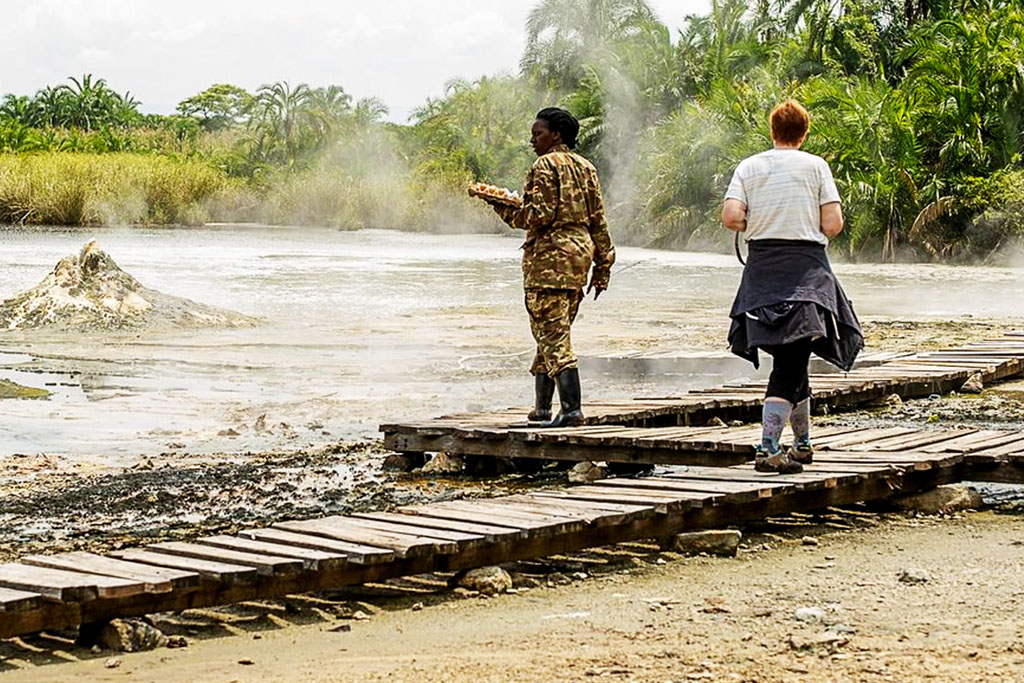Semuliki Forest Reserve was created in 1993 and upgraded to national park status in 1993. This 220km park lies on the floor of the Albertine Rift Valley just 670-760m above sea level. The 700m descent from Fort Portal town to Semuliki is one of the most scenic drives in Uganda. The only tract of true lowland tropical forest in East Africa, Semuliki represents the eastern limit of the Congo’s Ituri Forest and contains numerous Congo-Guinea species at the eastern limit of their ranges.
The park’s 441 recorded bird species, including 35 found nowhere else in East Africa, 15 primate, 300 butterfly and 235 moth species make Semuliki as essential destination for serious naturalists. The Semuliki Valley is the 160km-long part of the Albertine Rift Valley between lakes Edward and Albert, on the remote, western side of the Rwenzori Mountains.
The valley, which is shared between Uganda and the Dem.Rep.Congo, contains wildlife from both Central and east Africa. The Ugandan section contains two wildlife-protected areas, the forested Semuliki National Park, which has a close affinity with the jungles of the Congo basin, and Toro Semuliki Wildlife Reserve, which contains classic East African savanna.

Our Insight
Semuliki National Park boasts a remarkably rich biodiversity. This is partly because its forest cover is extremely old, this being one a few patches of refugia that predate, and persisted through, the arid millennia of the last Ice Age, 12-18,00 years ago, Secondly, it represents the eastern limit of the vast jungles of the Congo and species from Congo-Guinea and East Africa biomes are both found here. If Semuliki species lists have been accumulating for over 25,000 years, the park contains evidence of even older processes: hot springs bubble up from the depths to demonstrate the powerful subterranean forces that have been shaping the rift valley during the last 14 million years.
Wild Life
Semuliki National Park’s location within the Albertine Rift ecosystem at the junction of continental climatic and ecological zones has resulted in a high diversity of plant and animal species. Many of the park’s plant and animal species are inhabitants of the Congo forests and exists at the eastern limit of their range in Semuliki. The park contains 53 mammal species, including an impressive 11 primates, all of which have been found within 6km of Sempaya. Five species of large mammals and 7 species of small mammals have not been recorded in other Ugandan parks while several others, including Dent’s Mona monkey, the central African red colobus, forest buffalo and the water chevrotain, occur nowhere else in East Africa.
Of the 1047 birds recorded in Uganda, 435 bird species (43%) are found in Semuliki National park. These include Albertine Rift Endemics such as the dwarf honey guide and purple-breasted sunbirds; 35 Congo-Guinea biome species found nowhere else in East Africa, including black dwarf hornbill, Nkulengu rail, Congo serpent eagle, Gabon woodpecker; and other species with very limited ranges such as white-tailed hornbill, capuchin babbler, blue-headed crested flycatcher and the orange weaver.
Local People
Four distinct ethnic groups live near the park, Bakonzo cultivate the shapes of the nearby Rwenzori Mountain; Bwamba farmers live along the base of the range; Batuku pastoralists graze their cattle on the open plains beside the Semuliki River; and Batwa Pygmies, traditionally hunter-gathers, live on the edge of the forest.
Access Roads
Two major roads lead from kampla to Fort Portal town, which is 60km from Semuliki. Kampala-Fort Portal via Mubende is 290kms (4-5hours) Kampala – Fort Portal via Mbara and Kasese is 465kms (7-8hrs). This route however offers worthwhile diversions to Lake Mburo National Park, Queen Elizabeth National Park and Rwenzori Mountains National Park. Follow the Bwamba Road out of Fort Portal towards the Rwenzori mountains.
The 60km drive (1-hour) drive to the park’s tourism office at Sempaya follows excellent new tarmac road with dramatic Rwenzori and rift valley scenery. Visitors might consider leaving their vehicle at Itojo for a 3hor walk to sempaya on the old Bwamba Road. This crosses the north Rwenzori ridge, which affords spectacular rift valley views.
Climate & Air
Semuliki receives an average annual of 1,250mm concentrated during March – May and September – December. Annual mean temperatures range from 18c minimum to 30c maximum, with relatively small daily variation.
Chartered flights can land at an airstrip on Toro Semuliki Wildlife Reserve.
Accomodation
Basic cottages and camping facilities are available at UWA’s Bumaga Camp near Sempaya. Please visit the UWA website for more information. A wide choice of accommodation is available in Fort Portal while a small selection of basic hotels can be found in Bundibugyo, 20km beyond Bumaga. Visit Site All Year Round but be prepared for Afternoon rain during the wet months.
